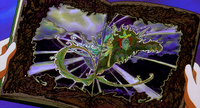Template:Main Page/Featured article: Difference between revisions
ElectAbuzzzz (talk | contribs) No edit summary |
m (grammar rules still apply) |
||
| Line 1: | Line 1: | ||
[[File:Entei_book.png|200px|right|An artist's interpretation of Entei, a legendary Pokémon.]] | [[File:Entei_book.png|200px|right|An artist's interpretation of Entei, a legendary Pokémon.]] | ||
'''[[Legendary Pokémon]]''' are a group of incredibly rare, and often very powerful {{OBP|Pokémon|species}}. While in English, all are typically grouped under the banner of "legendary" | '''[[Legendary Pokémon]]''' are a group of incredibly rare, and often very powerful {{OBP|Pokémon|species}}. While in English, all are typically grouped under the banner of "legendary," there are three distinct terms in Japanese that are used to refer to them. One, '''伝説のポケモン''' ''densetsu no Pokémon'', literally "Pokémon of legend", refers to Pokémon such as {{p|Kyogre}} and {{p|Groudon}}, who are featured prominently in the legends of the Pokémon world. A second, '''幻のポケモン''' ''maboroshi no Pokémon'', literally "Pokémon of illusions," refers to Pokémon seen so rarely, such as {{p|Mew}}, that some question their very existence. This term was translated in the [[Generation IV]] games as "mirage Pokémon," in reference to the various [[Sinnoh myths|myths of Sinnoh]], and many consider it to refer to Pokémon that are restricted to [[Nintendo event]]s, not available during the course of normal gameplay. The third and newest term is '''神話のポケモン''' ''shinwa no Pokémon'', literally "Pokémon of myth," which refers to the Pokémon which are spoken of as the creators of the Sinnoh region. | ||
<p style="font-size: small; text-align: right;">[[Legendary Pokémon|Read more of this article]] | [[Bulbapedia:Featured articles|More featured articles]]</p> | <p style="font-size: small; text-align: right;">[[Legendary Pokémon|Read more of this article]] | [[Bulbapedia:Featured articles|More featured articles]]</p> | ||
<noinclude>[[Category:Main Page components]]</noinclude> | <noinclude>[[Category:Main Page components]]</noinclude> | ||
Revision as of 12:21, 3 June 2010
Legendary Pokémon are a group of incredibly rare, and often very powerful Pokémon. While in English, all are typically grouped under the banner of "legendary," there are three distinct terms in Japanese that are used to refer to them. One, 伝説のポケモン densetsu no Pokémon, literally "Pokémon of legend", refers to Pokémon such as Kyogre and Groudon, who are featured prominently in the legends of the Pokémon world. A second, 幻のポケモン maboroshi no Pokémon, literally "Pokémon of illusions," refers to Pokémon seen so rarely, such as Mew, that some question their very existence. This term was translated in the Generation IV games as "mirage Pokémon," in reference to the various myths of Sinnoh, and many consider it to refer to Pokémon that are restricted to Nintendo events, not available during the course of normal gameplay. The third and newest term is 神話のポケモン shinwa no Pokémon, literally "Pokémon of myth," which refers to the Pokémon which are spoken of as the creators of the Sinnoh region.
